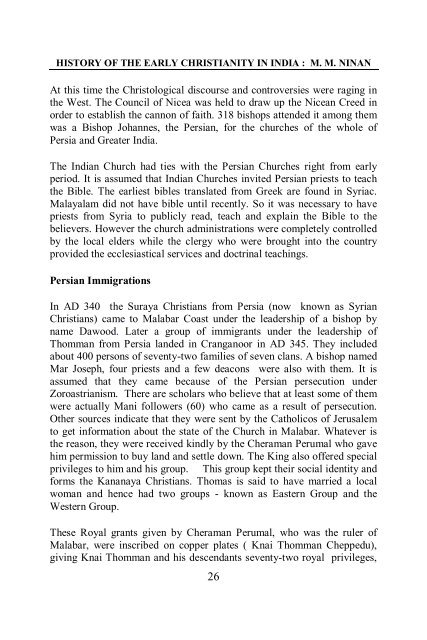History of Early Christianity in India
Create successful ePaper yourself
Turn your PDF publications into a flip-book with our unique Google optimized e-Paper software.
HISTORY OF THE EARLY CHRISTIANITY IN INDIA : M. M. NINAN<br />
At this time the Christological discourse and controversies were rag<strong>in</strong>g <strong>in</strong><br />
the West. The Council <strong>of</strong> Nicea was held to draw up the Nicean Creed <strong>in</strong><br />
order to establish the cannon <strong>of</strong> faith. 318 bishops attended it among them<br />
was a Bishop Johannes, the Persian, for the churches <strong>of</strong> the whole <strong>of</strong><br />
Persia and Greater <strong>India</strong>.<br />
The <strong>India</strong>n Church had ties with the Persian Churches right from early<br />
period. It is assumed that <strong>India</strong>n Churches <strong>in</strong>vited Persian priests to teach<br />
the Bible. The earliest bibles translated from Greek are found <strong>in</strong> Syriac.<br />
Malayalam did not have bible until recently. So it was necessary to have<br />
priests from Syria to publicly read, teach and expla<strong>in</strong> the Bible to the<br />
believers. However the church adm<strong>in</strong>istrations were completely controlled<br />
by the local elders while the clergy who were brought <strong>in</strong>to the country<br />
provided the ecclesiastical services and doctr<strong>in</strong>al teach<strong>in</strong>gs.<br />
Persian Immigrations<br />
In AD 340 the Suraya Christians from Persia (now known as Syrian<br />
Christians) came to Malabar Coast under the leadership <strong>of</strong> a bishop by<br />
name Dawood. Later a group <strong>of</strong> immigrants under the leadership <strong>of</strong><br />
Thomman from Persia landed <strong>in</strong> Cranganoor <strong>in</strong> AD 345. They <strong>in</strong>cluded<br />
about 400 persons <strong>of</strong> seventy-two families <strong>of</strong> seven clans. A bishop named<br />
Mar Joseph, four priests and a few deacons were also with them. It is<br />
assumed that they came because <strong>of</strong> the Persian persecution under<br />
Zoroastrianism. There are scholars who believe that at least some <strong>of</strong> them<br />
were actually Mani followers (60) who came as a result <strong>of</strong> persecution.<br />
Other sources <strong>in</strong>dicate that they were sent by the Catholicos <strong>of</strong> Jerusalem<br />
to get <strong>in</strong>formation about the state <strong>of</strong> the Church <strong>in</strong> Malabar. Whatever is<br />
the reason, they were received k<strong>in</strong>dly by the Cheraman Perumal who gave<br />
him permission to buy land and settle down. The K<strong>in</strong>g also <strong>of</strong>fered special<br />
privileges to him and his group. This group kept their social identity and<br />
forms the Kananaya Christians. Thomas is said to have married a local<br />
woman and hence had two groups - known as Eastern Group and the<br />
Western Group.<br />
These Royal grants given by Cheraman Perumal, who was the ruler <strong>of</strong><br />
Malabar, were <strong>in</strong>scribed on copper plates ( Knai Thomman Cheppedu),<br />
giv<strong>in</strong>g Knai Thomman and his descendants seventy-two royal privileges,<br />
26


















